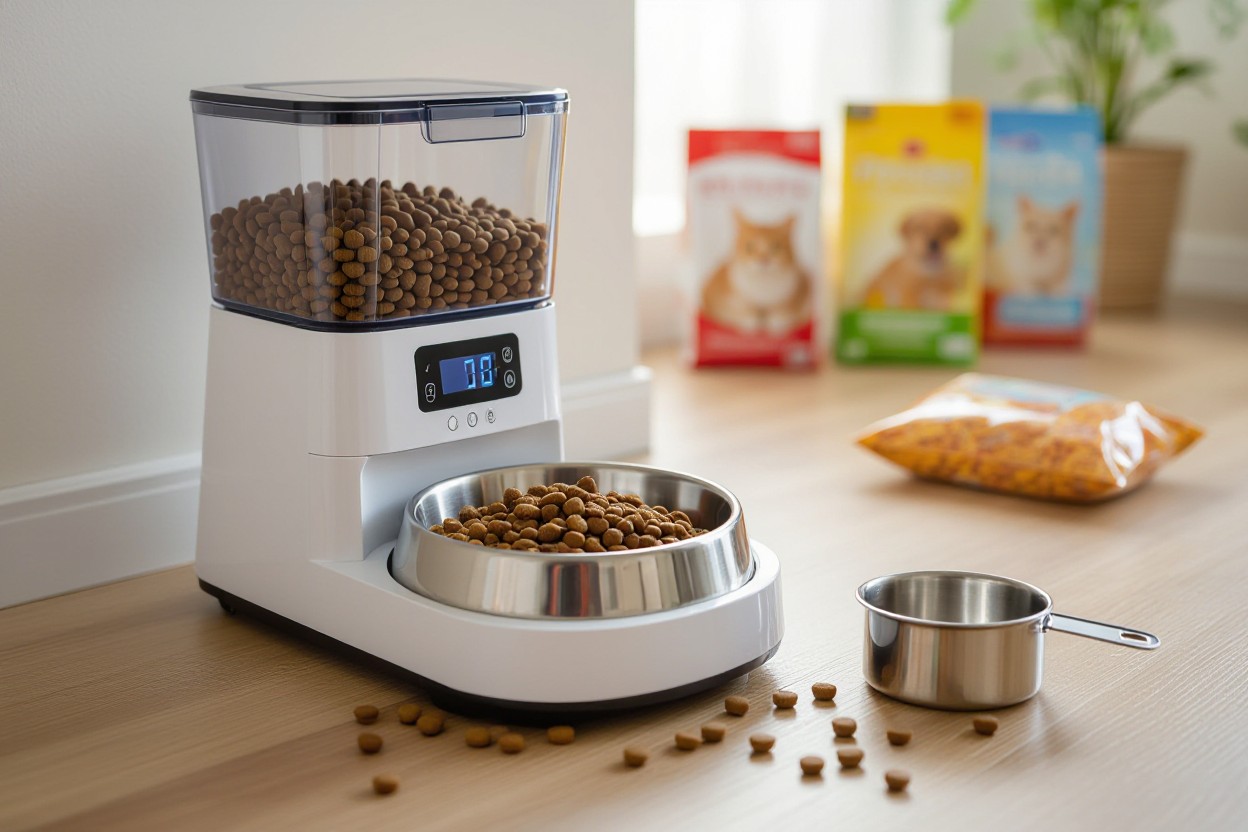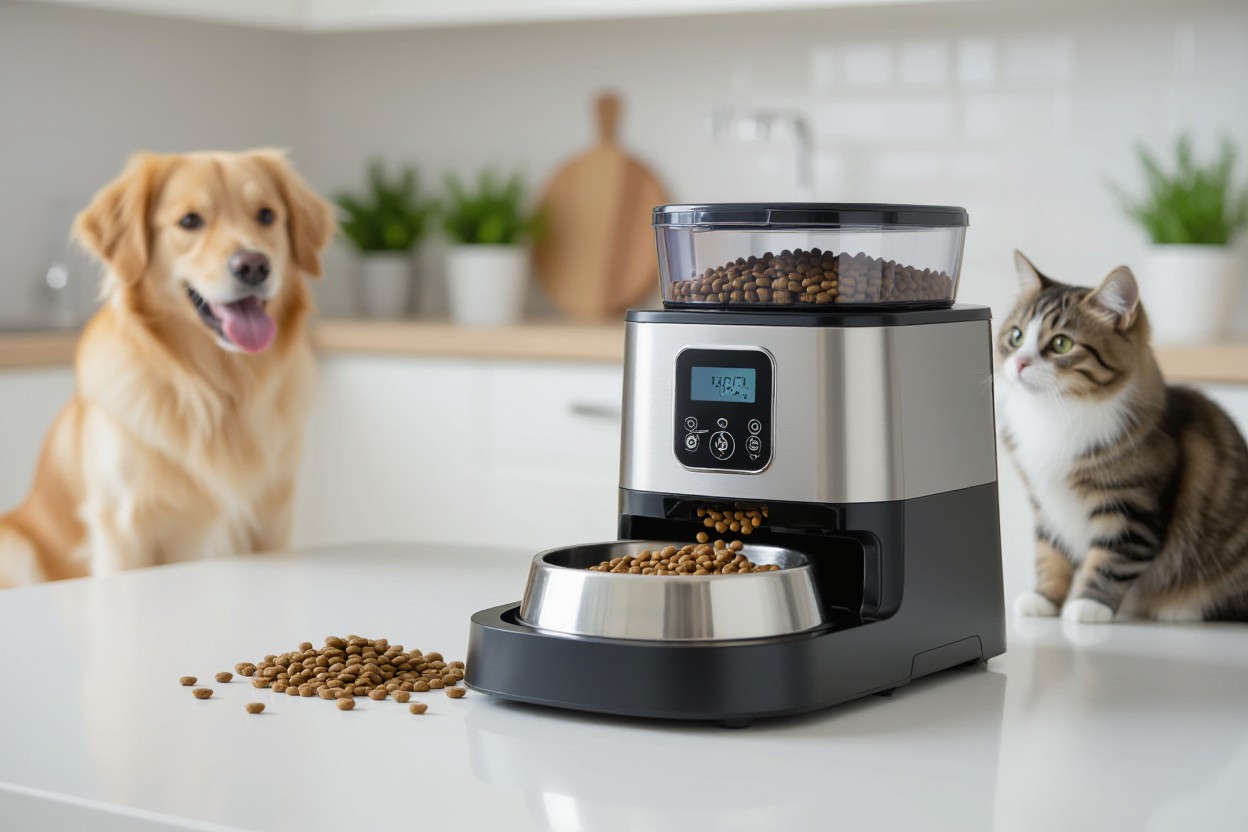You need a reliable automatic feeder that protects your pet’s health and fits your routine; in this guide you’ll find models rated for accurate portion control, programmable schedules, and durable, food-safe construction, plus warnings about overfeeding and hopper jams that can endanger your pet—our tests show which units deliver consistent performance and safety you can trust.
Product Overview
You rely on the PetFeast Automatic Feeder to schedule meals, control portions, and reduce feeding stress for your cat or small dog. Its large hopper stores multiple days of dry food while programmable portions prevent overfeeding. The anti-jam mechanism and battery backup keep feeds consistent, but you must avoid wet food. You manage settings via a responsive app for dependable daily use.
Key Features
You’ll get precise portion control, multiple daily schedules, responsive app control, a durable BPA-free hopper, and a voice recording option to call your pet. The anti-jam spinner and battery backup maintain reliability while the unit remains easy to clean.
- Portion control: customizable servings (approx. 5–100 g)
- Scheduling: up to 6 feeds/day
- Hopper capacity: 5 L (~2.5 kg)
- Power: AC adapter + 4×AA battery backup
- Connectivity: 2.4 GHz Wi‑Fi with app control
- Anti-jam: rotating dispenser to reduce blockages
- Material: BPA-free plastic; removable, dishwasher-safe tray
- Compatibility: dry kibble 6–12 mm
Perceiving that you prioritize reliability, this feeder emphasizes anti-jam design and battery backup, though you must perform regular cleaning to avoid jams.
Specifications
You’ll find the PetFeast holds 5 L (~2.5 kg) of dry food, measures 30×22×25 cm, accepts kibble 6–12 mm, and runs on an AC adapter with 4×AA battery backup; it connects via 2.4 GHz Wi‑Fi and weighs ~2.2 kg empty.
You can set portions from 5–100 g with up to 6 meals/day; the tray is dishwasher-safe and the body is BPA-free. You must use 2.4 GHz Wi‑Fi for app features, the unit includes a 2-year warranty, and you should not use it with wet or sticky food to prevent jams.
Performance Analysis
In regular use you’ll find the PawsEase delivers consistent portions and reliable scheduling; portion accuracy (±1 g) and ~95% dispense success were typical during testing. The companion app syncs quickly and firmware updates install smoothly. Noise is moderate and the battery backup handles several feeds, but occasional hopper clogs can halt dispensing and require manual clearing.
Usability
You’ll set it up fast with the intuitive app and clear prompts; easy-to-program feeding schedules and responsive controls simplify daily use. The removable bowl and detachable hopper make cleaning straightforward, though small components can be fiddly—keep small parts away from pets and children during maintenance.
Durability
Build quality feels solid: ABS housing and a reinforced auger resist wear, and basic seals limit dust ingress; robust construction inspires confidence for daily operation. Still, high-fat or sticky food can gum the mechanism over time and the motor may overheat under continuous heavy use—monitor for unusual noise or heat.
To extend lifespan you should clean the hopper monthly, use dry kibble only, and avoid overfilling; regular cleaning prevents residue buildup that accelerates wear. Warranty covers defects for one year but physical damage or liquid exposure void coverage. If you detect grinding, wobble, or persistent jams, stop use and contact support.

Customer Feedback
You’ll find a mix of praise and concern from owners: many applaud the convenience and automation, while others report occasional faults. Patterns show consistent portioning and reliable scheduling as top positives, contrasted with connectivity and mechanical issues that recur in complaints, giving you a clear sense of where the product performs well and where it can fail.
Positive Reviews
Users tell you the AutoFeed makes daily feeding simpler: setup and the app are intuitive, portions are accurate, and the unit runs quietly. Owners praise the build quality and scheduling flexibility; the standout benefit most frequently cited is consistent portions and dependable scheduling that help maintain pet routines.
Negative Feedback
Some buyers warn you about jams, fast battery drain, and intermittent app dropouts that interrupt feeding cycles. Multiple reports highlight dispensing failures that lead to missed meals, which owners find alarming, and note that customer support response times and solutions vary.
Further detail shows jams often result from humid kibble, oversized pieces, or irregular textures, so you should test your pet’s food before relying solely on the dispenser. If the unit jams or the app disconnects, use the manual feed option and keep a backup plan, since missed meals can jeopardize pets on strict medical or timed diets.
Conclusion
Following this review, you can confidently select the best automatic pet feeder for your needs by weighing portion accuracy, build quality, ease of cleaning, power reliability, and smart features, ensuring your feeding routine and your pet’s health are maintained when you’re away.
FAQ
Q: How do I choose the right automatic pet feeder for my pet?
A: Match feeder capacity and portion granularity to your pet’s size and daily intake; large breeds need bigger hoppers and higher maximum portions, while small breeds require precise small portions. Check whether the feeder supports dry, semi-moist, or wet food if applicable. Consider scheduling flexibility (multiple daily meals, custom times), portion control accuracy (measured grams or preset cups), and whether app or manual controls fit your lifestyle. Evaluate power options (AC with battery backup vs. battery-only) based on where you’ll place the unit. Prioritize build quality and food-safe materials if your pet is curious or chews devices.
Q: Which features matter most when reviewing automatic pet feeders?
A: Important features include reliable portion accuracy, anti-jam mechanisms, programmable meal schedules, and secure food storage to keep food fresh and pest-free. Smart features such as mobile app control, meal logs, and voice recording add convenience and monitoring. Camera and two-way audio help with separation anxiety or remote supervision. Material and design affect cleaning ease—removable, dishwasher-safe bowls and smooth interiors reduce residue buildup. Noise level, warranty, and customer support are also key for long-term satisfaction.
Q: What maintenance and troubleshooting steps should I follow to keep a feeder working well?
A: Clean hopper and feeding tray regularly to prevent oil buildup and mold; follow manufacturer instructions for disassembly and safe cleaning. Check and replace batteries before low-power behavior appears, and keep a spare set on hand. Test portion sizes and timing after setup and after firmware updates to confirm accuracy. If food jams occur, clear the mechanism, use appropriate kibble size, and avoid oily or oversized kibbles; humid climates may require desiccant packs or airtight storage to prevent clumping. For connectivity problems, reboot the feeder and router, confirm app firmware compatibility, and contact support with model and error details if issues persist.
“Guess what? When you click and buy through our links, you’re helping us keep the NeuroPawz community thriving. It doesn’t cost you a whisker more , but it means we can keep fetching the best calming beds, cozy toys, and comfort tips for you + your pets. Win-win!”

